Ericsson
Ericsson expects continuing network equipment sales challenges in 2024
Ericsson expects challenges in the mobile-network industry to continue this year as customers remain cautious about spending and as the investment pace normalizes in its key Indian market. The Swedish telecommunications-equipment company said sales in its network equipment unit fell 23% in the fourth quarter, with sales momentum in India slowing, while North America had a 50% drop in sales.
Ericsson, the world’s biggest western vendor of 5G network equipment, had a 10% drop in sales on a constant-currency basis in 2023, despite a renewed focus on cost cutting. Reported revenues fell 3%, to 263.4 billion Swedish kronor (US$25.2 billion), and Ericsson’s closely monitored gross margin shrank from 41.7% to 38.6%. After impairment charges affecting Vonage, the VoIP software company Ericsson bought for $6.2 billion in July 2022, the Swedish vendor went from a SEK19.1 billion ($1.8 billion) net profit the year before to a SEK26.1 billion ($2.5 billion) loss.
Ericsson saw a shift in its business mix through 2023 from higher-margin 5G work in early-mover markets like North America to lower-margin developing markets such as India. This helped keep sales levels propped up but has held margins back.
The rapid phase of 5G deployments in India is now moderating, with sales in the country growing by 14% on year, but declining by almost 40% compared with the third quarter.
“A reduction in capex investments in India was expected in the beginning of 2024 but occurred earlier than anticipated,” Ericsson said in a statement.
“It is important to note that, looking historically, large declines in the mobile network market are followed by a rebound,” said Börje Ekholm, Ericsson’s CEO, on his usual quarterly call with analysts. “Operators can sweat the assets up to a point but eventually will need to invest to manage the data traffic growth, cost, energy usage and, of course, network quality, and give the customer the experience that the customer demands.”
“As we look ahead, 2024 will be a difficult year and market conditions will prevail, and so we currently expect the market outside China to further decline as our customers remain cautious and the investment pace normalizes in India,” said Ekholm. A speedy rollout of 5G in the huge Asian country slowed down massively in the final quarter, explaining why Ericsson’s network sales in India fell sequentially by as much as 40%.
Ericsson reported a net profit attributable to shareholders of 3.39 billion Swedish kronor ($324 million) compared with SEK6.07 billion a year earlier, as sales fell 16% to SEK71.88 billion. Analysts polled by FactSet had expected a net profit of SEK3.29 billion on sales of SEK76.64 billion.
The earnings before interest, tax and amortization margin excluding restructuring charges stood at 11.4%, beating company guidance of around 10%. The Swedish company expects the overall network market to shrink in 2024 and the near-term outlook remains uncertain, mainly due to the decline in India as well as generally cautious customer investments.
However, Ericsson expects to gain market share in North America toward the latter part of 2024 thanks to its recent $14B Open RAN contract win from AT&T. That deal has been heavily promoted by Ericsson and AT&T as an “open RAN” affair. Disaggregated network equipment with “open interfaces”would permit AT&T to pair Ericsson Open RAN gear with that from other Open RAN hardware vendors. Although Fujitsu has been named as another supplier of Open RAN radios, the contract will clearly make AT&T more dependent on Ericsson than it is today.
This author doesn’t believe the reported $14B deal will be totally realized, because AT&T will not deploy much, if any, Open RAN this year.
Ericsson also remains hopeful that Vonage can bring about a recovery. Along with other parts of the industry, it has been working to standardize the application programming interfaces (APIs) between the 5G network and the apps it would support. The idea is that a software developer would be able to write better 5G apps after paying for access to the Vonage platform where these network features are exposed. Money would trickle down to operators and they, in turn, would be more inclined to invest in network upgrades.
“In our view, the current investment levels are unsustainably low for many operators,” Chief Executive Borje Ekholm said. “We are therefore confident that a market recovery should materialize. However, the timing of market recovery is ultimately in the hands of our customers.”
PHOTO: LARS SCHRODER/AGENCE FRANCE-PRESSE/GETTY IMAGES
References:
https://www.wsj.com/business/telecom/ericsson-sees-network-challenges-continuing-in-2024-0c127a4e
https://www.lightreading.com/5g/ericsson-eyes-more-cuts-after-slashing-9-000-jobs-as-outlook-dims
Recon Analytics (x-China) survey reveals that Ericsson, Nokia and Samsung are the top RAN vendors
NTT advert in WSJ: Why O-RAN Will Change Everything vs. AT&T selects Ericsson for its O-RAN
Ericsson Mobility Report touts “5G SA opportunities”
.
Ericsson Mobility Report touts “5G SA opportunities”
State of 5G SA:
“It’s been exciting to see the industry evolve in the last decade or so, and see first-hand the massive growth of 4G and the arrival of 5G,” said Fredrik Jejdling Executive Vice President and Head of Business Area Networks and Publisher of Ericsson Mobility Report.
The latest edition of Ericsson’s Mobility Report opens with the assertion that “5G standalone brings new opportunities,” which sounds promising, but there’s nothing in the report which shows what those opportunities are.
Ericsson says that 40 service providers have deployed or launched 5G SA in public networks, which agrees with Analysys Mason’s findings. To put that in context, around 280 service providers globally have launched commercial 5G with the overwhelming being 5G NSA.

Dell’Oro counted just seven 5G SA launches to date in 2023, while the GSA – which worked with Ericsson on the stats for its Mobility Report – shared data that also showed little growth in 5G SA this year.
………………………………………………………………………………………………………………………………………….
- 1. 6 bn Global 5G mobile subscriptions are projected to reach 1.6 billion by the end of 2023.
- 30% 5G mid-band population coverage outside mainland China has increased from 10 percent in 2022 to around 30 percent at the end of 2023.
- 56 GB Global mobile data traffic consumption per smartphone is expected to reach 56 GB per month at the end of 2029.
Ericsson predicts that there will be 1.6 billion 5G subs in the world by the end of this year, or 18% of all mobile subscriptions, driven by North America, where 5G penetration will reach 61%. As recently as June, the network equipment vendor forecast that the year-end 5G total would hit 1.5 billion, so clearly the market is increasing faster than expected. In the third quarter there were 163 million 5G subscriber additions taking the total to 1.4 billion by the end of September. As such, the year-end target look eminently achievable.
Ericsson puts total global 5G subscriptions at 5.3 billion by the end of 2029, by which date 5G network coverage should reach 85% of the population, up from 45% at the end of this year.
“With more than 600 million 5G subscriptions added globally this year, and rising in every region, it is evident that the demand for high performance connectivity is strong,” said Fredrik Jejdling, Executive Vice President and Head of Networks, at Ericsson. “The roll-out out of 5G continues and we see an increasing number of 5G standalone networks being deployed, bringing opportunities to support new and more demanding applications for both consumers and enterprises,” he added.
References:
https://www.ericsson.com/en/reports-and-papers/mobility-report
https://www.telecoms.com/5g-6g/5g-subs-exceed-expectations-but-they-re-not-standing-alone
Analysys Mason: 40 operational 5G SA networks worldwide; Sub-Sahara Africa dominates new launches
GSA 5G SA Core Network Update Report
Dell’Oro: Mobile Core Network market has lowest growth rate since 4Q 2017
Vodafone Germany deploys Ericsson 5G radio to cut energy use up to 40%
Vodafone Germany has partnered with Ericsson to deploy new power-saving radio technology on its 5G network. The radio unit 6646 bundles three different frequencies (900, 800 and 700 MHz) and radio cells in one system in the control center located at the bottom of a mobile base station. By bundling the active technology, 5G base stations function with 32-40% less power.

The advantage of mobile radio stations with area frequencies is that they provide particularly large areas with stable and reliable mobile radio coverage. By bundling the active technology of different frequency ranges and several radio cells in one unit, they now require between 32 and 40 percent less energy, according to trials on the Vodafone network. Following successful tests in the North Rhine-Westphalia (NRW) region, the telecommunications group is now successively activating the technology in the live network together with its technology partner Ericsson.
The new energy-saving radio from Ericsson has been intensively tested in the live network in Wachtendonk in the Lower Rhine region over the past few weeks. The positive test results demonstrate an energy-saving potential of up to 40 percent per 5G base station and are the reason for today’s large-scale rollout. The new technology will be installed and automatically activated in NRW, Rhineland-Palatinate, Hesse, Saarland and Baden-Württemberg during routine maintenance and modernization work.
Test results on the Vodafone network show that energy requirements can be reduced by more than 2,500 kilowatt hours (kWh) per mobile phone site per year by bundling the active technology. This is roughly equivalent to the annual energy requirement of a two-person household per mobile phone station. If the technology is activated on a large scale in the network, significantly more than 30 million kilowatt hours of electricity can be saved each year. At the same time, stable and reliable network coverage will also be strengthened in rural regions.
Vodafone Germany CEO Philippe Rogge, says: “For the first time, we are bundling the active antenna technology of different area frequencies in mobile communications. This is good for smartphone users in rural areas and good for our planet. Because with the new technology, we are bringing fast and reliable 5G networks even better to people in rural areas and deep into buildings. At the same time, we are reducing the energy requirements of our mobile phone antennas. We expect to be able to save more than 30 million kilowatt hours of electricity per year with large-scale activation in our network.”
Daniel Leimbach, Head of Western Europe at Ericsson, says: “Energy consumption reduced by up to 40 percent, weight reduced by 60 percent – around a year ago, we celebrated a world premiere at the launch of the Radio 6646 at the Eurolab in Aachen. At the Imagine Live Innovation Day in the research and development center, our experts presented the innovative 5G technology for the first time. We are all the more pleased that Vodafone is convinced of its performance and energy efficiency and is installing the technology in the area. Because only innovations that are scalable, economical and powerful at the same time deliver the full benefits for mobile customers and sustainability.
The technology in Ericsson’s new radio:
Ericsson’s new remote radio combines the different 5G area frequencies 900, 800 and 700 MHz as well as the components of several radio cells into one compact system in a more sustainable way. By bundling three frequencies and several radio cells, the transmission technology consumes significantly less energy for each individual frequency range at full power. In addition, the new radio is 60 percent lighter and therefore requires less energy and material in the manufacturing process.
On the way to CO2 neutrality:
The new antenna product is another building block on Vodafone’s path to becoming more sustainable step by step. The Düsseldorf-based company has set itself specific targets to be CO2-neutral by 2025. The network is the biggest and most important lever here. Vodafone Germany has therefore been sourcing 100 percent of its electricity from renewable sources since 2020. It is also constantly testing new technologies and solutions to make the German mobile network more sustainable and conserve resources. For example, the dynamic energy-saving mode in the mobile network has already been ensuring an intelligent adjustment between actual energy demand and consumption around the clock for over a year.
………………………………………………………………………………………………………………………………..
References:
Ericsson and Vodafone deploy new energy-efficient, light 5G radio in London
Ericsson and U.S. PAWR 5G SA network for rural agricultural research
TDC NET with Ericsson launch first 5G Standalone network in Denmark
Ericsson powers Singtel 5G SA core network; lightest and smallest Massive MIMO radio
Ericsson announces 5G standalone NR software and 2 new Massive MIMO radios
Ericsson, Vodafone and Qualcomm: 1st Reduced Capability 5G data call in Europe
Ericsson, Vodafone and Qualcomm have demonstrated the first RAN Reduced Capability (RedCap) [1.] 5G data sessions on a European network, paving the way for a multitude of IoT and other connected devices to transmit data more simply and efficiently.
Note 1. 3GPP RedCap is a variation of 5G technology that was introduced in 3GPP Release 17 in mid-2022 and will be included in ITU-R M.2150-1. It provides reduced capability 5G New Radio (NR) devices for the mid-range segment. RedCap NR features include: Reduced UE complexity Fewer RX/TX antennas Reduced UE bandwidth use Lower UE power consumption Relaxed data rates Relaxed UE processing time and processing capability RedCap’s speeds, latency, and spectrum use are similar to advanced LTE capabilities. It’s considered the 5G heir to LTE Cat-4, with speeds of tens to hundreds of Mbps.
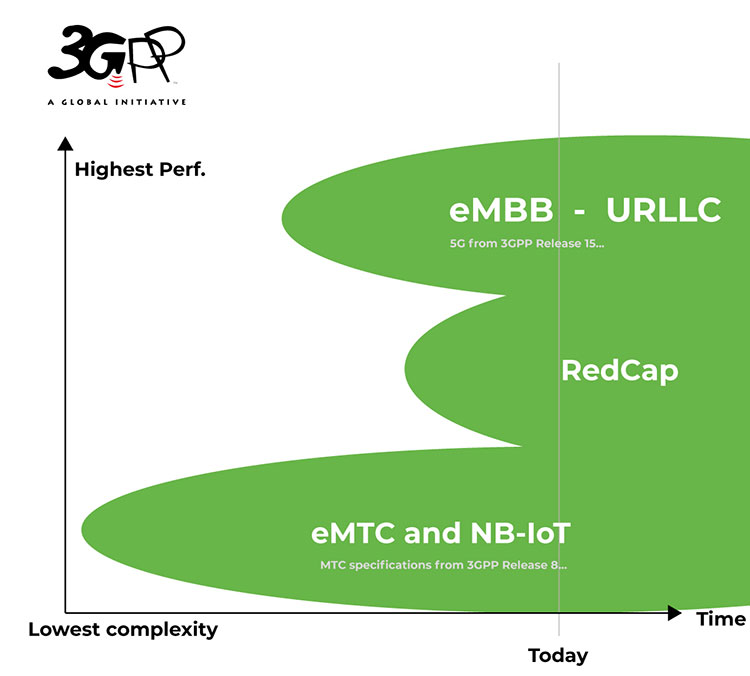
……………………………………………………………………………………………………………………………
The successful demo took place on 21 September 2023 in the Spanish city of Ciudad Real, running on Ericsson’s RedCap RAN software using Vodafone Spain’s live testing 5G network ‘CREATE’ (Ciudad Real España Advanced Testing Environment).
RedCap enables connectivity for simpler device types, allowing many more devices to connect to 5G networks and transmit data at low power and lower cost, enhancing existing 5G use cases and unlocking new ones. These advantages apply to many different devices, from consumer wearables such as smartwatches to a wide range of IoT devices like smart water meters.
The technology, called New Radio Light (NR-Light), works with less complex devices that can be smaller, more cost-efficient, and enjoy longer battery life than traditional mobile broadband devices. NR-Light can also complement the network APIs developed by Vodafone for its customers to extend the battery life of their devices.
The joint demonstration in Spain leveraged the Qualcomm Snapdragon® X35 platform, the world’s first NR-Light modem RF. The Snapdragon X35 platform bridges the complexity gap between high-speed mobile broadband devices, and low-bandwidth, low-power devices. The demo is part of preparations for the introduction of Snapdragon-based commercial devices which are expected in 2024.
“This successful demonstration is an exciting moment for OEMs, network operators and network users, because it highlights a clear path to new devices and commercial use cases,” said Dino Flore, Vice President, Technology, Qualcomm Europe Inc. “The use of commercial 5G networks for lower-bandwidth applications is an important milestone, not least because this offers a migratory path for low-power devices with a 5G architecture, which also draws on the current and future benefits offered by 5G standalone (5G SA). We will continue to work with customers, industry and our partners to accelerate the creation of 5G devices which present exciting new use cases for enterprises and consumers.”
“Vodafone is able to continually evolve and improve its network for customers by being first to test the latest technologies. We are delighted that our unique multi-vendor 5G network, CREATE, was able to host and validate such an innovative trial in collaboration with Qualcomm and Ericsson,” said Francisco Martín, Head of Open RAN, Vodafone. “The results show that networks will be able to support many more energy efficient connected devices in the future.”
“We are very happy to be partnering with Vodafone and Qualcomm to perform Europe’s first 5G Reduced Capability data call,” said Isidro Nieto, Global Customer Unit Vodafone, Head of Technology Networks, Ericsson. “5G Redcap opens up new use cases for both enterprise and consumer segments such as industrial sensors, lower cost 5G routers as well as wearables. Ericsson embraces new ways to fully realize the value of 5G services and this joint demo shows that that the support for RedCap is gaining market momentum.”
…………………………………………………………………………………………………………………………..
Earlier this year, Juniper Research said the number of 5G IoT roaming connections will reach 142 million by 2027, up from just 15 million this year. IoT will account for 27% of all 5G roaming connections in four years time.
References:
https://www.3gpp.org/technologies/redcap
https://www.techradar.com/pro/iot-is-set-to-push-5g-connections-into-the-billions
ITU-R M.2150-1 (5G RAN standard) will include 3GPP Release 17 enhancements; future revisions by 2025
Ericsson’s India 6G Research Program at its Chennai R&D Center
Today at the India Mobile Congress 2023, Ericsson announced the launch of its ‘India 6G‘ program with the establishment of an India 6G Research team at its Chennai R&D Center. Ericsson stated that the ‘India 6G’ team consists of senior research members and a team of experienced researchers in Radio, Networks, AI, and Cloud. They have been tasked with developing fundamental solutions for the future.
The India Research team, in collaboration with Ericsson research teams in Sweden and the US, will work together to develop the technology that will enable the delivery of a cyber-physical continuum. In this continuum, networks will provide critical services, immersive communications, and omnipresent IoT, all while ensuring the integrity of the delivered information.
The 6G Research team in India, in collaboration with Ericsson Global Research teams, will develop novel solutions. The teams are working on various projects, including Channel Modelling and Hybrid Beamforming, Low-energy Networks, Cloud Evolution and Sustainable Computing, Trustworthy, Explainable, and Bias-Free AI algorithms, Autonomous Agents for Intent Management Functions, Integrated Sensing and Communication Functions for the Man-Machine Continuum, and Compute Offload to Edge-Computing Cloud, among others.
“By establishing a dedicated 6G research team for in-country research, contextual to India’s need and collaborating with the world class research programs across international research labs, we look forward to incorporating the needs of India into the mainstream of telecommunication technology evolution. “stated Magnus Frodigh, Head of Research at Ericsson.
Ericsson says it is partnering with premier institutes in India for Radio, AI and Cloud Research. The company said, “AI Research is of high importance to Ericsson as the 6G networks would be autonomously driven by AI algorithms. Ericsson is also looking to partner with other premier engineering institutes in India for 6G related research.”
The Centre for Responsible AI is an interdisciplinary research centre that envisions becoming a premier research centre for both fundamental and applied research in Responsible AI with immediate impact in deploying AI systems in the Indian ecosystem. AI Research is of high importance to Ericsson as the 6G networks would be autonomously driven by AI algorithms. Ericsson is also looking to partner with other premier engineering institutes in India for 6G related research.
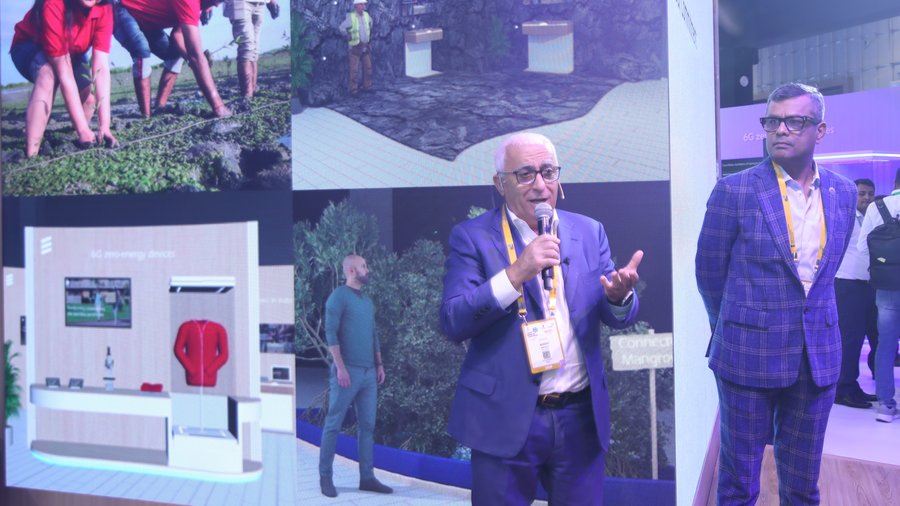
Ericsson in India:
Ericsson is reportedly partnering with Communication Service Providers, Bharti Airtel, and Reliance Jio to deploy 5G in the country.
According to the statement, Ericsson has been present in India since 1903, and the Ericsson Research team was established in 2010. With the establishment of 6G Research in India, Ericsson looks forward to playing a key role in advancing this technology in the country.
The company has three R&D centres in India, located in Chennai, Bengaluru, and Gurgaon.
References:
https://www.ericsson.com/en/press-releases/2/2023/10/ericsson-initiates-india-6g-program-in-india
https://telecomtalk.info/ericsson-announces-india-6g-program-at-imc2023/889172/
India unveils Bharat 6G vision document, launches 6G research and development testbed
Enable-6G: Yet another 6G R&D effort spearheaded by Telefónica de España
Nokia to open 5G and 6G research lab in Amadora, Portugal
6th Digital China Summit: China to expand its 5G network; 6G R&D via the IMT-2030 (6G) Promotion Group
China to introduce early 6G applications by 2025- way in advance of 3GPP specs & ITU-R standards
Telecom layoffs continue unabated as AT&T leads the pack – a growth engine with only 1% YoY growth?
As we have repeatedly stated, the entire telecom industry is in a funk and the 2024 outlook is looks just as gloomy as this year. MTN claims that telecom is a zero growth industry (see References below) and that certainly seems to be true. Let’s start with AT&T – the largest telco in the U.S. with 229.2M wireless subscribers as of Q2-2022.
In the first nine months of 2023, AT&T has shed 10,200 employees, including nearly 4,000 in the recent third quarter alone. AT&T cut many more jobs – 39,700 in total – in 2022 when it was in the process of spinning out Warner Media to Warner Brothers Discovery (the deal closed on April 8, 2022).
AT&T’s CEO told reporters last week that the U.S. based teclo plans to reduce costs by another $2 billion over the next three years. That’s after Stankey boasted that the company has cut costs by $6 billion in the last three and in an “inflationary environment.”
AT&T is hardly a growth company and has tons of debt. In the 3rd quarter of 2023, AT&T reported revenues of $30.4 billion, up only 1% year over year. Yet Stankey had the audacity to say in a press release, “Our investments in best-in-class 5G and fiber connectivity are fueling our growth engine. We’re gaining profitable customer relationships and becoming more efficient. This is powering our strong business performance.”
Today, LightReading announced the departure of a key AT&T executive. Jason Inskeep, previously the senior assistant VP for AT&T’s 5G Center of Excellence and focusing on the operator’s work in private wireless networking and edge computing, recently left the company for a senior director position at consulting firm Slalom.
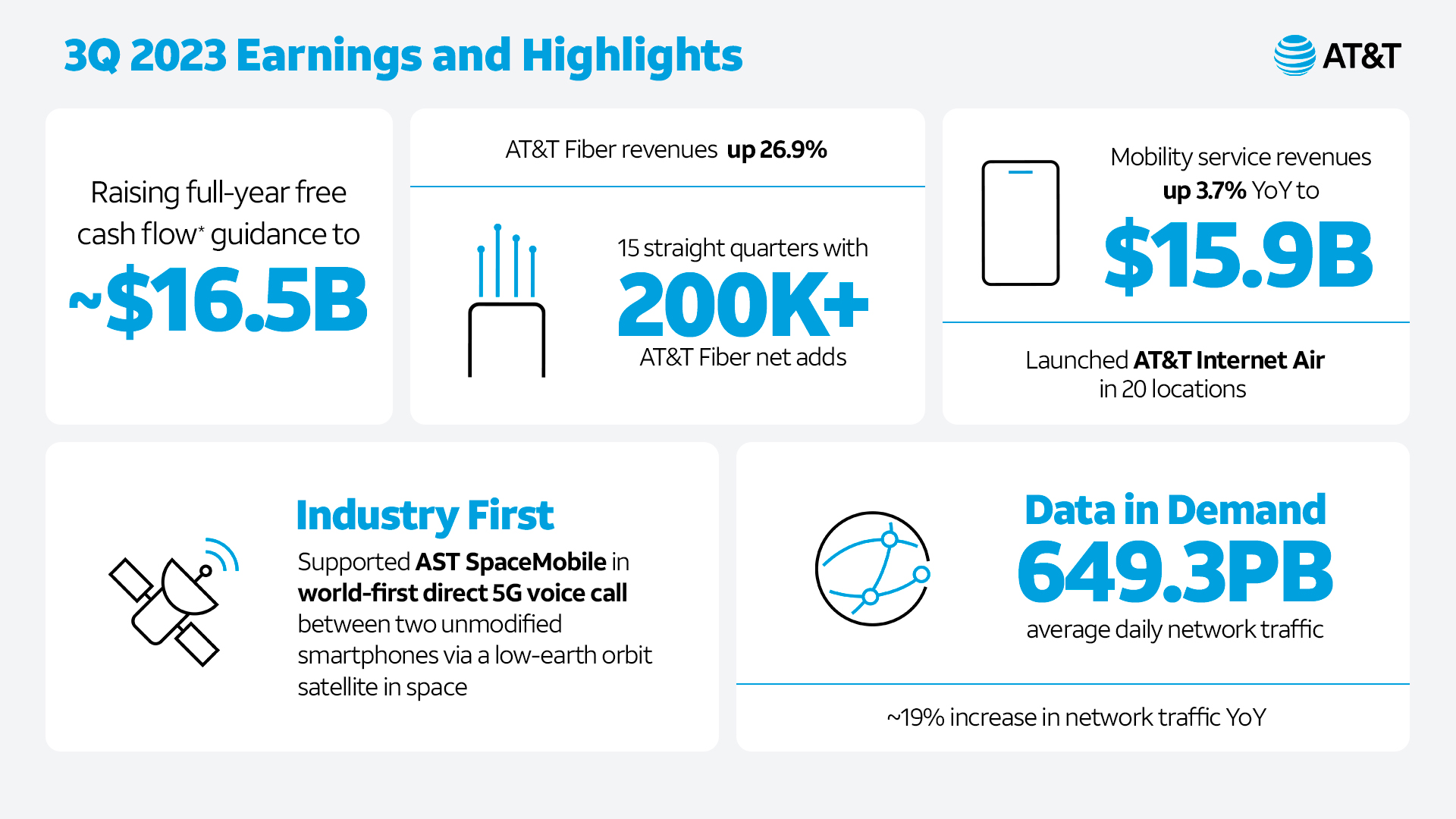
Iain Morris of LightReading wrote on October 20th, “The future AT&T is conceivably a cohort of antenna-carrying robots, some AI that writes code and Stankey with his feet up on the table, providing the only whiff of humanity.”
AT&T is not the only U.S. telco reducing its workforce. Earlier this year, T-Mobile announced that it will be laying off ~5,000 workers or around 7% of its workforce. This latest job cutting move will primarily impact employees in corporate, back-office, and technology roles, while those in retail or customer care positions will not be affected.

……………………………………………………………………………………………………………………………….
Network Equipment Vendors Layoffs and Gloomy Outlook:
Last week, Nokia said the company plans to cut at least 9,000 jobs and as many as 14,000 over the next three years. That’s mainly due to weak 5G equipment demand. Nokia CEO Pekka Lundmark told reporters that Nokia’s sales have plummeted in North America (sales were down 40%) and that India’s 5G rollout is now slowing down as expected.
Over the next three years, his latest target is to reduce annual costs by between €800 million (US$843 million) and €1.2 billion ($1.3 billion). It’s a move that will reduce Nokia’s headcount by at least 9,000 roles from its current level of roughly 86,000. And at the upper end of the range, it will see an exodus of 14,000 employees, more than 16% of the total.
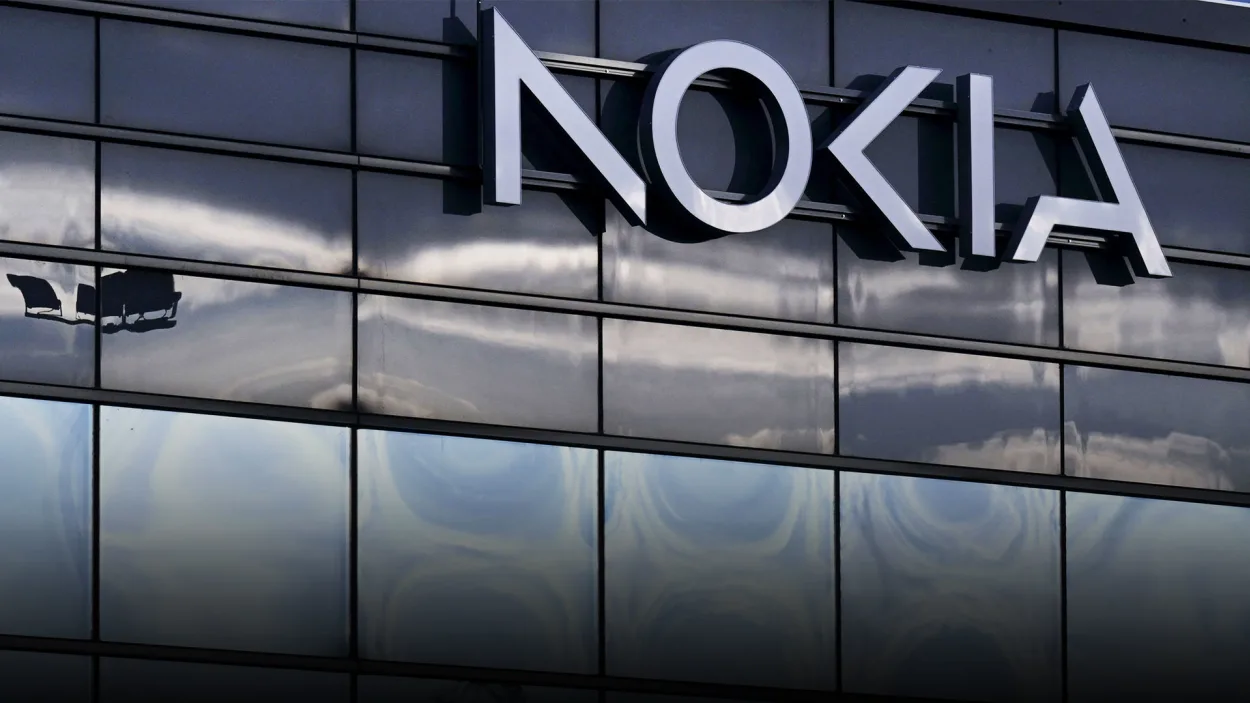
Ericsson CEO Borje Ekholm cautioned of persistent macroeconomic uncertainty into 2024 which it expects will impact customers’ investment ability, as the wireless network equipment vendor reported a year-on-year net loss of SEK30.5 billion ($2.8 billion) from net income of SEK5.4 billion in Q2 2022, due to a SEK32 billion charge related to the acquisition of cloud company Vonage in 2022. In February, Reuters reported that Ericsson will lay off 8,500 employees globally as part of its plan to cut costs, a memo sent to employees.
……………………………………………………………………………………………………………………..
Semiconductor Layoffs:
Wireless network chip maker Qualcomm is slashing 1,258 jobs in California, including nearly 200 in the Bay Area, in the latest tech layoffs to hit the region. Qualcomm said in state filings that it will lay off approximately 194 workers in its Santa Clara offices and another 1,094 employees at its San Diego headquarters. The cuts are slated to begin Dec. 13th, based on a notice submitted to state officials this week. The job cuts represent roughly 2.5% of Qualcomm’s workforce and mark the second round of layoffs for the wireless semiconductor company this year.
The Qualcomm layoff news comes about a month after the company announced a deal with Apple to provide 5G chips through at least 2026. Qualcomm is also the chip supplier for the newly announced Meta Quest 3. It is only 1 of 2 companies that sell 5G end point silicon on the merchant market (Taiwan based MediaTek is the other one).
It’s not a pretty picture to say the least for telecom industry employees.
References:
https://www.lightreading.com/ai-machine-learning/at-t-seems-on-a-mission-to-be-a-zero-employee-telco
https://www.lightreading.com/private-networks/at-t-s-private-wireless-chief-departs
https://about.att.com/story/2023/q3-earnings.html
Inside AT&T’s newly expanded $8 billion cost-reduction program & huge layoffs
High Tech Layoffs Explained: The End of the Free Money Party
MTN Consulting’s Network Operator Forecast Through 2027: “Telecom is essentially a zero-growth industry”
Ericsson and Google Cloud expand partnership with Cloud RAN solution
Ericsson has announced an expansion of its successful and long-standing partnership with Google Cloud to develop an Ericsson Cloud RAN solution on Google Distributed Cloud (GDC) [1.] that offers integrated automation and orchestration and leverages AI/ML for additional communications service providers (CSP) benefits. The companies have successfully demonstrated the full implementation of the Ericsson vDU and vCU on GDC Edge and the solution is running live in the Ericsson Open Lab in Ottawa, Canada, with joint ambition for market development.
Note 1. GDC is a portfolio of fully managed hardware and software solutions which extends Google Cloud’s infrastructure and services to the edge and into your data centers.
Deploying Ericsson Cloud RAN on GDC Edge enables the delivery of a fully automated and very large-scale distributed cloud, resulting in an efficient, reliable, highly performant and secured software centric radio access network infrastructure. In this setup, the on-premises GDC Edge is managed using functions such as fleet management from the public cloud through a dedicated secure connection between on-prem hardware and the cloud, while also addressing sovereignty and privacy requirements of the CSP customers. This architecture ensures the clear path for CSPs toward the implementation of a fully hybrid cloud solution for RAN.
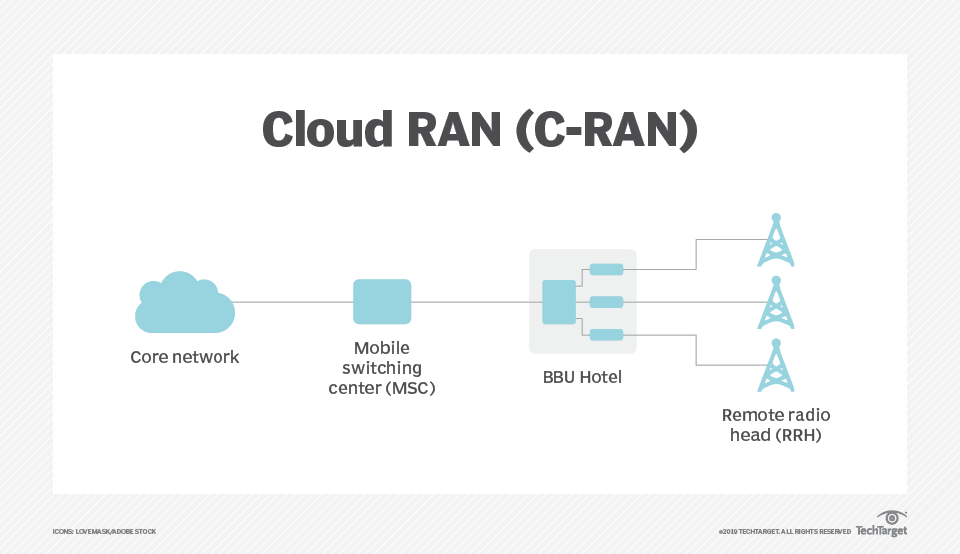
Cloud RAN comprises a mobile switching center, a BBU hotel and a remote radio head
C-RAN networks comprise three primary components:
- A BBU hotel. This is a centralized site that functions as a data or processing center. Individual units can stack together without direct linkage or interconnect to dynamically allocate resources based on network needs. Communication between units has high bandwidth and low latency.
- A remote radio unit (RRU) network. Also known as a remote radio head, an RRU is a traditional network that connects wireless devices to access points.
- A fronthaul or transport network. Also known as a mobile switching center, a fronthaul or transport network is the connection layer between a BBU and a set of RRUs that use optical fiber, cellular or mmWave communication.
………………………………………………………………………………………………………………………………………………………………………………………………………….
Running Ericsson Cloud RAN on GDC Edge will enable CSPs to utilize Google Cloud Vertex AI, BigQuery and other cloud services, to improve the usability of the massive data sets being provided by Cloud RAN applications. This in turn, will open a number of opportunities for CSPs to control, inspect, configure, and optimize their RAN infrastructure.
Ericsson Cloud RAN provides CSPs additional choice for creating networks based on open standards and interfaces using multiple vendors. The Ericsson Cloud RAN solution is infrastructure agnostic, allowing RAN applications to be deployed on any infrastructure chosen by the CSP. Ericsson is continuously collaborating with ecosystem partners and adapting its Cloud RAN applications to work on different infrastructures and configurations.
To further a cloud-native automation approach to network workloads, Ericsson and Google Cloud are jointly enhancing the solution through the Linux Foundation open-source project Nephio (a Kubernetes-based automation platform for deploying and managing highly distributed, interconnected workloads such as 5G network functions), where we jointly drive standardization of critical functionality.
Mårten Lerner, Head of Product Line Cloud RAN, Ericsson, says: “This partnership enables us to deepen and expand our valuable collaboration with Google Cloud, and it opens new opportunities for operators to utilize the benefits of cloud-native solutions and automation. Ericsson remains committed to ensuring the adaptability of its Cloud RAN applications on diverse cloud infrastructures, offering operators enhanced flexibility and choice in deploying Cloud RAN as well as supporting the evolving hybrid cloud architectures together with Google Cloud.”
Gabriele Di Piazza, Senior Director, Telecom Products, Google Cloud, says:
“We’re proud to enable Ericsson Cloud RAN to run on Google Distributed Cloud Edge infrastructure, which includes access to our AI/ML capabilities as well as cloud-native automations. We’re delighted to recognize Ericsson as a distinguished Google Cloud Partner and look forward to a continued strong partnership in support of our mutual customers.”
https://www.techtarget.com/searchnetworking/definition/cloud-radio-access-network-C-RAN
Ericsson and O2 Telefónica demo Europe’s 1st Cloud RAN 5G mmWave FWA use case
Cloud RAN with Google Distributed Cloud Edge; Strategy: host network functions of other vendors on Google Cloud
Vodafone Trials Nokia’s Cloud RAN; Other 5G Research Partnerships
Nokia launches anyRAN to drive CloudRAN partnerships for mobile network operators and enterprises
Omdia and Ericsson on telco transitioning to cloud native network functions (CNFs) and 5G SA core networks
Ericsson and U.S. PAWR 5G SA network for rural agricultural research
Ericsson in cooperation with the U.S. National Science Foundation’s (NSF) Platforms for Advanced Wireless Research (PAWR) program announced the launch of its 5G SA network for public research together with the Agriculture and Rural Communities (ARA) team at Iowa State University (ISU). Powered by Ericsson, the network is part of ARA’s multi-modal platform for wireless research, based on the ISU campus with coverage extending to local crop and livestock farms and parts of the city of Ames.
The Ericsson-powered 5G SA network will be used to support precision agriculture applications, along with other research initiatives, and is already connecting farm sites that previously had little to no broadband access. ARA is partnering with the ISU Department of Agriculture and Biosystems Engineering as well as the College of Agriculture of Life Sciences for initial precision agriculture research projects.
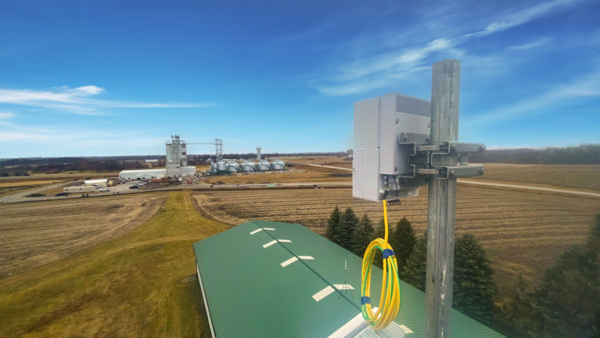
Ericsson and PAWR light up 5G network for rural agricultural research
Image Credit: Ericsson
“As we continue to unlock 5G’s full potential, we’re excited to support ARA’s cutting-edge research on precision agriculture, rural broadband, renewable energy, and public safety for smart and connected rural communities,” said Per Wahlen, Vice President and Head of Business Development, Ericsson North America.
Sample agriculture research will include using connected robots (PhenoBots) to collect plant phenotyping data with stereoscopic cameras generating 800 megabits per second worth of sensor data per camera. It will also include livestock monitoring with high-resolution cameras, as well as agriculture automation.
The Ericsson-powered network consists of a 5G core operating in SA mode and NR radios which operate in both mid-band and millimeter wave spectrum bands with a high aggregate throughput up to 3Gbps. The outdoor network will run 5G SA with mid and high band New Radio-Dual Connectivity (NR-DC) with a downlink exceeding 2.5Gbps in outdoor live testing. With ultra-low latency, increased capacity and coverage, and support for end-to-end network slicing, Ericsson’s 5G SA solutions ensure instant response times and enable new use cases.
ARA is part of the National Science Foundation-funded Platforms for Advanced Wireless Research (PAWR) program that works to create wireless testbeds through public-private partnerships to accelerate the nation’s wireless ecosystem.
“As ARA aims to help close the gap between academic and industry research in the wireless and agricultural sectors, we’re excited to announce the Ericsson network component, which is open for joint opportunities for both academic and industry research endeavors,” said Hongwei Zhang, Principal Investigator of ARA and Director of the Center for Wireless, Communities and Innovation, Iowa State University.
Andrew Wooden of telecoms.com wrote:
The concept of the smart farm – like the smart city – made up part of the hype fodder for the initial 5G launch. Since 5G SA is considered ‘proper’ 5G the line seems to now be that it will be the required driving force behind all sorts of industries being revolutionised by high bandwidth and low latency mobile connectivity.
How large a commercial market applications like this represents for kit vendors like Ericsson in the near future remains to be seen, but if it does represent a teaser of how food can be grown better or more abundantly – as is presumably the end goal – we can think of much more frivolous use cases presented over the years.
These 5G SA networks my play an important role in the future of the U.S. agricultural ecosystem. ARA and Ericsson are in forward-leaning positions to support the realization of recently proposed bipartisan legislation surrounding the issue of broadband access to unserved rural farms, through applied research and innovative use case development to assist farmers and rural communities.
TDC NET with Ericsson launch first 5G Standalone network in Denmark
Danish digital infrastructure provider TDC NET, together with Ericsson, have launched the first 5G Standalone (5G SA) network in Denmark. The transition to high-performance 5G SA technology will enhance the regional 5G ecosystem, accelerate innovation across industries, and unlock exciting possibilities for consumers.
In September 2020, TDC NET went live with the first non-standalone (NSA) 5G network in Denmark, which worked alongside the existing 4G infrastructure provided by Ericsson.
Ericsson press release states: “This milestone signifies a monumental leap forward in connectivity, enabling transformative advancements and placing Denmark at the forefront of technological progress.”
“A 5G Standalone network provides lower latency, higher efficiency, better spectrum utilization, more reliable connectivity, and lower device battery consumption than other networks. It unlocks more use cases for consumers, critical IoT, enterprises and industrial automation. 5G SA also facilitates network slicing benefits for multiple customer segments, offering an infrastructure for businesses to enable, for instance, smart manufacturing and IoT-driven innovation, while giving consumers better and more consistent service experience. It is also a big step forward for communications service providers as it enables a more flexible approach to service creation and provision for subscribers.”
–>Those are all nice features but do any of them represent a monumental leap forward? 5G SA, aka true 5G (vs fake 5G=5G NSA=4G infrastructure/core with a 5G NR RAN) has yet to prove that in its limited global deployments. Where are the new 5G SA revenue streams?
Jakob Dirksen CTO of TDC NET, says: “We were the first to introduce 5G in Denmark and now we are taking the next big step by switching on 5G Standalone. This will offer consumers, enterprises and industries enhanced efficiency, safety, and a range of opportunities across everything from self-driving cars, remote work, healthcare, as well as mission-critical operations by authorities. In addition, 5G Standalone will also enable energy efficiency improvements thanks to more data being transmitted with the same amount of energy and faster access to content.”
One of the key benefits of 5G SA will be improved speed capabilities. Over a 5G SA network, TDC NET and Ericsson have already achieved an impressive 7Gbps downlink peak throughput in a live site environment that has been equipped with Ericsson Radio System products supporting millimeter wave and mid-band spectrum. Enabling New Radio Dual Connectivity (NR-DC) mode through Ericsson’s 5G Core and high modulation scheme have been key to this achievement.
A 5G trial at the Tour de France 2022 in Copenhagen, Denmark used Ericsson Massive MIMO radios on 5G TDD (time division duplex) spectrum. It delivered up to 13 times more data with the same energy consumption compared to LTE FDD (frequency division duplex).
Niclas Backlund, Country Manager for Ericsson Denmark, says: “With the 5G Standalone network, we are now able to accelerate the Danish 5G ecosystem and provide a world-class mobile network with a range of new opportunities for consumers and businesses by enabling slicing, and thereby providing service differentiation. By modernizing legacy networks and then upgrading to 5G, communication service providers can lower operating costs thanks to greater energy efficiency and thus reduce total cost of ownership. And, at the same time, they can future-proof their networks for anticipated higher capacity needs and offer customers value through new services and capabilities.”
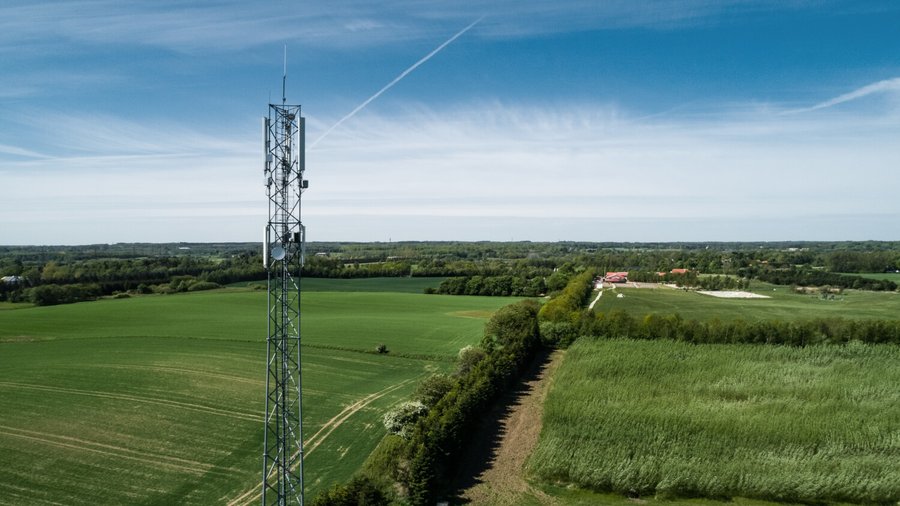
In addition, 5G SA uses a dedicated 5G core network, which means that data transmission requires less signaling than with 5G NSA. This is because 5G SA devices do not need to switch between the 4G and 5G core networks, which can reduce latency and improve performance.
The 5G Standalone deployment in TDC´s commercial network is expected to contribute to the service provider’s roadmap towards Net Zero emissions target by 2030, says Ericsson. Also, the 5G SA network was said to signal major overall progress in TDC NET’s technological transformation as it adopts cloud-native software architecture, leading to fast and reliable service innovation for subscribers with service providers using TDC NET’s 5G network, while maintaining improved efficiency and network performance.
References:
Ericsson and Vodafone enable Irish rugby team to use Private 5G SA network for 2023 Rugby World Cup
BT and Ericsson wideband FDD trial over live 5G SA network in the UK
Swisscom, Ericsson and AWS collaborate on 5G SA Core for hybrid clouds
Counterpoint Research: Ericsson and Nokia lead in 5G SA Core Network Deployments
Omdia and Ericsson on telco transitioning to cloud native network functions (CNFs) and 5G SA core networks
Bouygues Telecom picks Ericsson for cloud native 5G SA core network
Ericsson powers Singtel 5G SA core network; lightest and smallest Massive MIMO radio
Ericsson: Global 5G subscriptions close to 1.3 billion in Q2-2023
According to Ericsson’s Mobility Report update, approximately 260 communications service providers (CSPs) have launched commercial 5G services. About 35 CSPs have launched 5G standalone (SA) networks. The Q2-2023 additions bring the global number of 5G subscriptions close to 1.3 billion.
India continues to lead the world in 5G subscription growth rate with more than seven million of the 175 million global subscriptions added between April and June (the second financial quarter – Q2) 2023 accounted for in the country.
China had the second highest country growth rate with more than five million 5G additions during Q2.
The United States was in third place with more than three million 5G subscription additions.
The four-page August 31 update is an addendum to the full edition of the Ericsson Mobility Report, published in June 2023. It focuses on recent updates to the quarterly subscription and traffic data sections.
Other information in the Q2-2023 update includes:
- In Q2 2023, the number of mobile subscriptions totalled 8.3 billion, with a net addition of 40 million subscriptions during the quarter. The number of unique mobile subscribers is 6.1 billion.
- Global mobile subscription penetration was 105 percent.
- The number of mobile broadband subscriptions grew by about 100 million in the quarter, totalling 7.4 billion, a year-on-year increase of five percent. Mobile broadband now accounts for 88 percent of all mobile subscriptions.
- Mobile data traffic grew by 33 percent between Q2 2022 and Q2 2023.
- 4G subscriptions increased by 11 million, totalling about 5.2 billion and representing 62 percent of all mobile subscriptions.
- WCDMA/HSPA subscriptions declined by 85 million and GSM/EDGE-only subscriptions dropped by 59 million during the quarter. Other technologies fell by about two million.
References:
https://www.ericsson.com/en/news/2023/8/emr-q2-2023-update
https://www.ericsson.com/en/reports-and-papers/mobility-report/reports/june-2023
Ericsson Mobility Report: 5G monetization depends on network performance
Ericsson Mobility Report: 5G subscriptions in Q2 2022 are 690 million (vs. 8.3 billion total mobile users)
June 2022 Ericsson Mobility Report: 5G subscriptions increased by 70 million in Q1-2022 to reach 620 million




